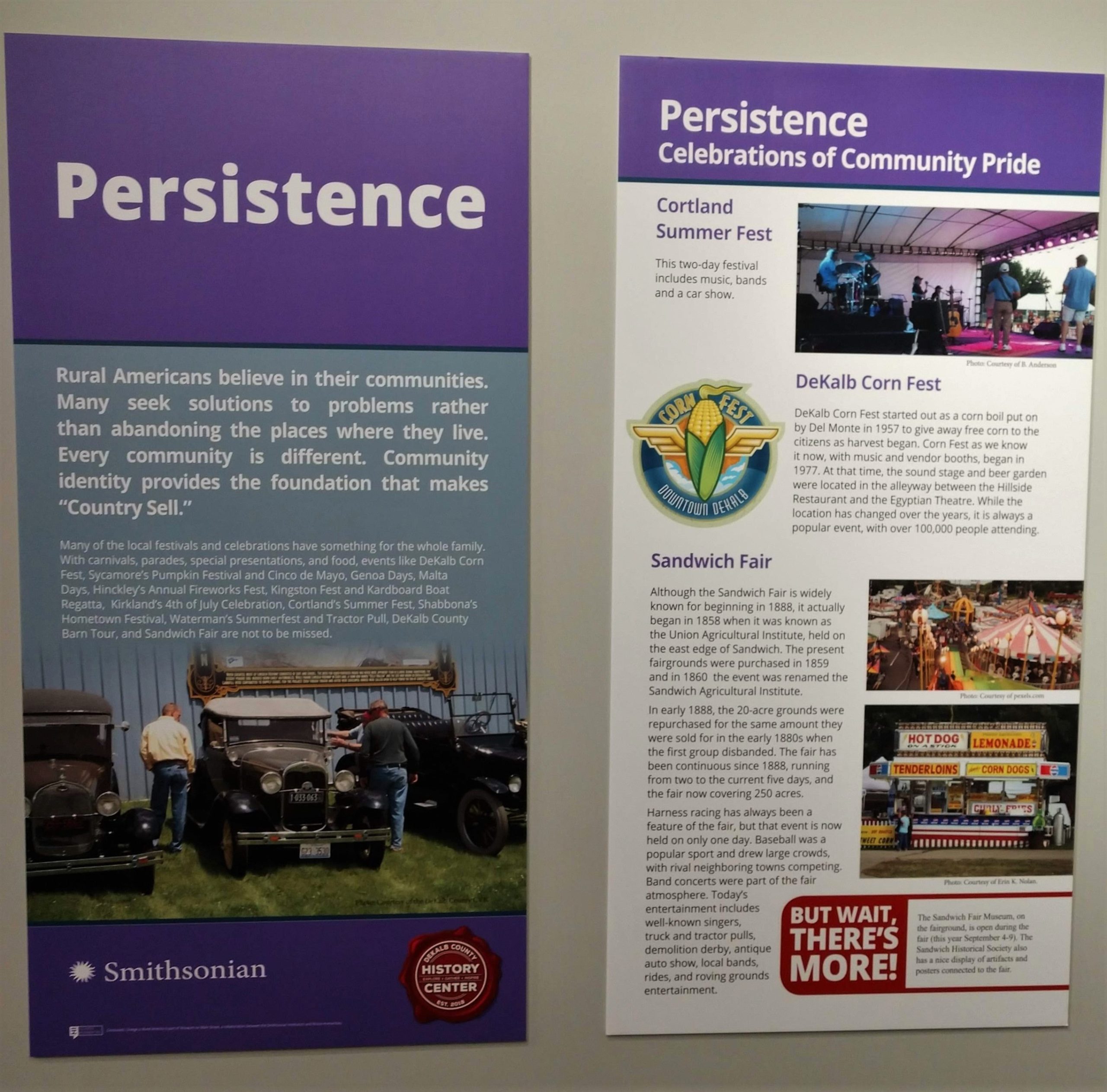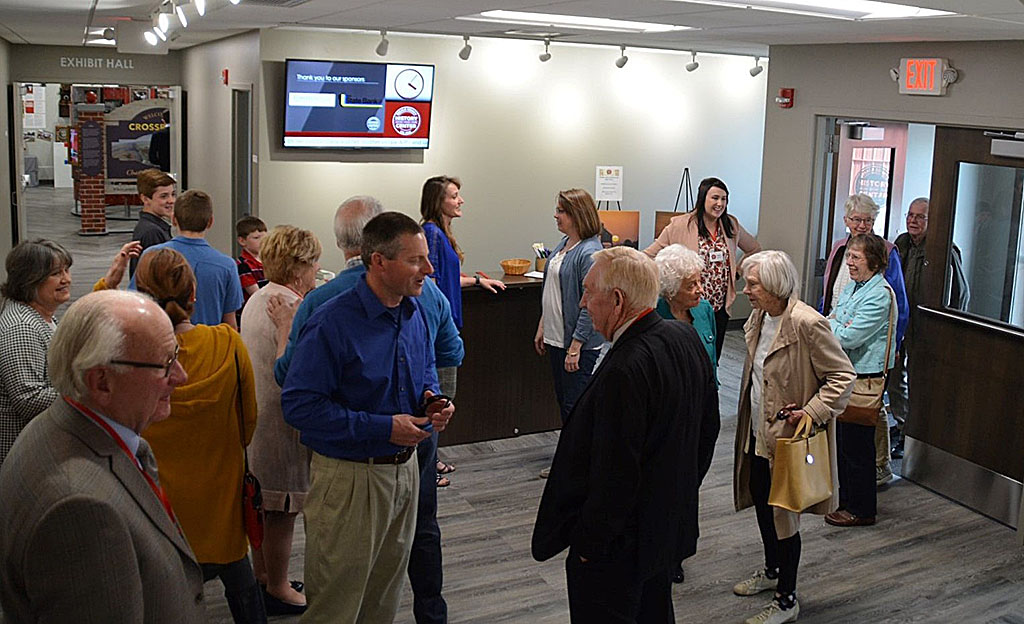Chapter 14: Making Bold Strides Together in DeKalb County
In DeKalb County, Crossroads: Change in Rural America inaugurated a new chapter in the life of a vital local institution, as well as a heightened degree of collaboration and mutual support among keepers of the county’s history.
Documentation of local agricultural history formed a component of the DeKalb County History Center’s Crossroads-related activity as well. Through the Smithsonian Institution’s “Stories YES” program, students at Sycamore Middle School interviewed members of several multigenerational farm families. These students also researched issues related to solar and wind power and documented organic agriculture in DeKalb County.[1] Their interview with Dan Kenney, founding director of DeKalb County Community Gardens, is featured in the October 2, 2020, episode of the Smithsonian’s Stories from Main Street podcast, entitled “How We Grow.” The history center’s collaboration with Sycamore Middle School represented only one of its many efforts to engage people and organizations throughout the county with Crossroads. Its preparations to host the exhibition coincided with its transformation from the Sycamore History Museum into the DeKalb County History Center, which culminated in the construction of a new, state-of-the-art facility. The opening of Crossroads on May 11, 2019, doubled as the grand opening of that facility.

The new building is situated on the same property where the Sycamore History Museum was located: the former Engh farmstead, which is owned by the city and lies on the outskirts of Sycamore. The original museum had been distributed among three buildings: Exhibitions were displayed in a tenant farmer’s house, which also held the museum’s collections of three-dimensional objects; public programs took place in a garage, which lacked climate control and therefore could not be used in especially cold or hot weather; and the office and archives were located in a hired hand’s house.

Now, however, the DeKalb County History Center occupies a 7,600-square-foot facility, the construction of which was funded by a capital campaign that raised $1.6 million.

The center includes a 1,200-square-foot exhibition space, a multipurpose room where programs can be held, and a large collection storage area. The building also houses the Joiner History Room, the county’s historical archive, previously located within Sycamore Public Library.[2]

Part of the impetus for converting the Sycamore History Museum into the DeKalb County History Center and constructing a new facility to house it was that both the museum and the Joiner History Room were outgrowing their physical settings. Another significant factor, however, was an aspiration to respond to the challenges experienced by the more than twenty small museums and historical societies distributed throughout the county, only about five of which have paid staff. DeKalb County is geographically relatively large, extending more than thirty-five miles from north to south. Approximately half of its population is concentrated in and around the communities of DeKalb and Sycamore, located near the center of the county, while the county’s northern and southern areas are considerably less densely populated. Consequently, access to resources needed by cultural institutions, including human resources, is distributed unevenly.
The leadership of the Sycamore History Museum believed that pooling of resources and coordination of efforts could help history organizations throughout DeKalb County, especially those located in less populous areas, to fulfill their missions more effectively and contribute toward their long-term sustainability. One motivation for expanding the Sycamore History Museum’s purview to encompass all of DeKalb County was to enable the museum to serve as the hub of a countywide network of history-oriented institutions. The museum’s staff and board used the opportunity for engagement with Crossroads: Change in Rural America as a catalyst for the development of that informal network.

Executive Director Michelle Donahoe explained, “Part of that discussion involved the application for Crossroads because we figured that would be a really powerful springboard to getting this project going. Having the Museum on Main Street and the Smithsonian name brought credibility right off the bat to what we were trying to do. Granted, the Sycamore History Museum had been around since 1999, but we were branding a whole new organization, the DeKalb County History Center, and to a whole new audience, and so being able to say that Illinois Humanities and the Smithsonian were involved in this project—people were a little bit more receptive to sitting down and talking with us, so that was huge.”[3]

Representatives of some small museums initially expressed concern that the new DeKalb County History Center might try to acquire artifacts from their collections, but discussions with the center’s staff and board assured them otherwise. The center presented Crossroads-related programs in various DeKalb County locations. Its staff also assisted several organizations throughout the county in developing exhibition panels on themes relevant to both Crossroads and the subject matter in which those institutions specialize, which were then displayed in those organizations’ venues. Conversely, some of those organizations contributed content and loaned artifacts for the center’s Crossroads companion exhibition.

As if constructing and moving into a new building and developing a mutually beneficial network of local institutions were not sufficiently ambitious projects to undertake simultaneously, the DeKalb County History Center, in consultation with partners throughout the county, also produced an elaborate companion exhibition. For each main section of the Crossroads exhibition, a corresponding segment of the companion exhibition examined the same theme in relation to DeKalb County, describing how the county’s history and culture have manifested and sometimes contributed to national trends. Thus, the exhibition implicitly made a case for DeKalb County as a microcosm of rural America.
“If I was approaching this from Sycamore history, I might have just picked one topic, but since we were approaching this as a county and a big part of our vision was partnerships, I just saw so many opportunities, I didn’t want to miss any,” Donahoe commented.[4]

The section of the companion exhibition entitled “Identity” (analogous to the segment of Crossroads with the same name) included data regarding agriculture in DeKalb County. Visitors learned, for instance, that as of 2017, farmland occupied 88 percent of the county’s land area. There were about 2,300 farms in the county, averaging 1,309 acres each. The average value of farmland was $10,900 per acre. DeKalb County farms generated about $359 million in sales of agricultural products.
The “Identity” segment also featured entries in the center’s “What Is Rural?” photography contest. Interspersed among them were observations and memories shared by members of local farm families. One recalled, “During the summer, ladies brought pies, cakes, and fruit to the fields for the workers. The kitchen gardens included corn, peas, carrots, and pumpkins. We would have bonfires in the backyard with family–ate s’mores and talked with each other.” Another commented, “In the early summer, there are about seven to ten days when the rows of corn [planted thirty inches apart] first branch out, and you can’t see the rows any longer. The field is a sea of green. Later, the leaves relax, and you can see the separate rows again.”[5]

“The Land” discussed the Prairie Band Potawatomi’s proposal for a casino, DeKalb County’s role in the development of barbed wire, the DeKalb County Forest Preserve District, and current debates about wind and solar power.[6] “Community” noted that the basketball team later known as the Harlem Globetrotters played its very first game in 1927 against the Hinckley Merchants in the small town of Hinckley—and the Merchants won! The segment also described the histories of two culturally and architecturally significant local arts and entertainment venues: the Sandwich Opera House in Sandwich and the Egyptian Theatre in DeKalb, both of which were restored in the 1980s and remain in use.[7]

“Building for the Future” discussed the importance of African American and Latino and Latina migration to DeKalb County, as well as the evolution of farming within the county and its contributions to agricultural innovation. The section also described the local impact of railroads, the Good Roads Movement, and the introduction of telephones; the development of educational institutions, including the founding in the mid-1960s of Kishwaukee College, a community college in Malta that originally prioritized learning opportunities for farmers and their families and remains closely connected with local agriculture; and the activities of local 4-H clubs and Future Farmers of America chapters. “Persistence” examined how place-based festivals in DeKalb County both reflect and contribute to a spirit of community.

Like the Atlanta Museum’s “Classrooms & Community” exhibition, the DeKalb County History Center’s companion exhibition earned an award of excellence from the Illinois Association of Museums. Much of the companion exhibition’s textual and visual content is available for viewing at https://dchcexhibits.org/crossroads/.[8]
Donahoe emphasized that the input of volunteers from partner organizations based in various DeKalb County communities was vital to the development of the exhibition. Those countywide partners suggested topics with which the center’s Sycamore-based staff and board members were largely unfamiliar and loaned materials that otherwise would not have been available. “We really depended on them to help tell their communities’ stories. I don’t think we could have done it any other way,” she said.

Many of the exhibition panels included sidebars labeled “But wait, there’s more!” They informed viewers of other museums and historic sites in the county where visitors could learn about the subject matter in more detail. “We wanted to kind of share the wealth of the benefit of us hosting it, but we also really wanted to let people know about these other great treasures throughout the county,” Donahoe explained.

She expressed optimism that the organizations that cooperated with the center to make Crossroads a countywide experience will stay connected and collaborate on future projects: “That Smithsonian name started a conversation where people were willing to participate, and then they had a good experience, so I think that set us up for success for the future.”[9]

- Michelle Donahoe, telephone interview with author, September 27, 2019; Shannon Sullivan, “Students Collaborate with New DeKalb County History Center in Illinois,” Museum on Main Street, accessed April 2, 2023, https://museumonmainstreet.org/blog-node/students-collaborate-new-dekalb-county-history-center-illinois. ↵
- Katrina J.E. Milton, “Making History: DeKalb County History Opens,” The Associated Press, May 12, 2019, https://apnews.com/article/045637d4fd1d4fffbb6851adca5503c9, no longer available as of October 2023. ↵
- Michelle Donahoe, telephone interview with author, September 27, 2019. ↵
- Michelle Donahoe, telephone interview with author, September 27, 2019. ↵
- “Identity,” section of a companion exhibition accompanying Crossroads: Change in Rural America, DeKalb County History Center, Sycamore, IL, May 11-June 22, 2019, content from which is available at https://dchcexhibits.org/crossroads/identity/. ↵
- “The Land,” section of a companion exhibition accompanying Crossroads: Change in Rural America, DeKalb County History Center, Sycamore, IL, May 11-June 22, 2019, content from which is available at https://dchcexhibits.org/crossroads/land/. ↵
- “Community,” section of a companion exhibition accompanying Crossroads: Change in Rural America, DeKalb County History Center, Sycamore, IL, May 11-June 22, 2019, content from which is available at https://dchcexhibits.org/crossroads/land/. ↵
- “Building for the Future,” section of a companion exhibition accompanying Crossroads: Change in Rural America, DeKalb County History Center, Sycamore, IL, May 11-June 22, 2019, content from which is available on the Crossroads Exhibit webpage. ↵
- Michelle Donahoe, telephone interview with author, September 27, 2019. ↵



